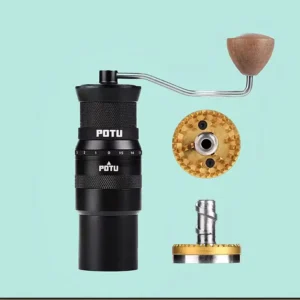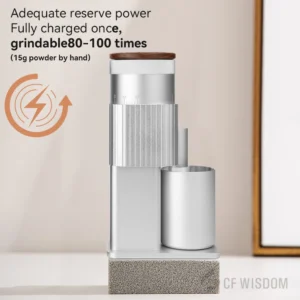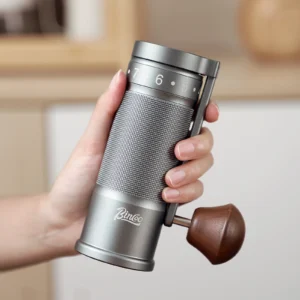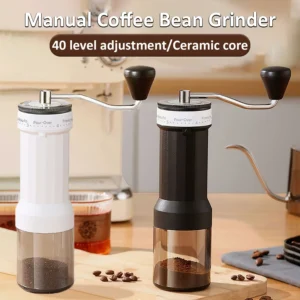Introduction to Espresso Grind Size
Finding the perfect espresso grind size can feel like searching for a mythical treasure – elusive and frustrating. The truth is, there’s no universal “magic number” that works for everyone. Your ideal grind setting depends on your specific grinder, the coffee beans you’re using, your espresso machine, and even environmental factors like humidity and temperature.
Despite this variability, grind size remains the most critical factor in espresso extraction. It directly controls:
- How water flows through your coffee puck
- How much flavor is extracted from your beans
- The balance between acidity, sweetness, and bitterness
- The overall consistency and quality of your shots
While espresso grind typically falls within the 200-400 micron range (finer than table salt but similar to fine sugar), understanding the principles behind finding your perfect setting matters more than chasing a specific number.
Throughout this guide, we’ll develop a systematic approach to help you find the optimal grind size for your specific setup. This journey requires patience and attention to detail, but the reward – consistently delicious espresso – makes it worthwhile. Developing this skill will transform your home espresso experience by giving you control over the most fundamental aspect of fine-tuning espresso grind size.
The Science Behind Espresso Extraction
To master espresso grind size, you need to understand what’s happening inside your machine during extraction. Espresso brewing is a precise process that relies on three primary factors working in harmony:
Pressure
An espresso machine forces water through ground coffee at approximately 9 bars of pressure (about 130 pounds per square inch). This pressure is what extracts flavor compounds so quickly compared to other brewing methods.
Time
A properly extracted espresso typically takes between 25-35 seconds from when you start your machine to when your target yield is reached.
Temperature
Ideal extraction occurs when water temperature sits between 195-205°F (90-96°C).
Grind size connects all these elements by controlling resistance to water flow. When coffee is ground finer, it creates more surface area exposed to water while simultaneously creating more resistance. This balance is crucial – too much resistance (too fine) and water struggles to pass through; too little resistance (too coarse) and water flows too quickly without proper extraction.
On a molecular level, different flavor compounds extract at different rates. Acids extract quickly, followed by sugars, then finally bitter compounds. When your grind size is properly set, you create the ideal environment for balanced extraction of these compounds, resulting in harmony between brightness, sweetness, and richness in your cup.
Understanding how grind size affects espresso provides the foundation for making informed adjustments rather than random changes when troubleshooting extraction problems.
Recognizing Extraction Problems: Too Coarse vs. Too Fine
Being able to diagnose extraction issues is essential for making proper grind adjustments. Here’s how to recognize the two primary problems:
Too Coarse (Under-extraction)
- Visual Signs:
- Shot runs very quickly (under 20 seconds)
- Thin, pale blonde stream
- Watery appearance with minimal crema
- Stream may appear broken or inconsistent
- Taste Characteristics:
- Sour, sharp, acidic flavor
- Lacks sweetness and body
- Tastes weak and underdeveloped
- Finish disappears quickly
- Flow Behavior:
- Espresso rushes out of portafilter
- Volume builds rapidly
- Crema is thin and dissipates quickly
Too Fine (Over-extraction)
- Visual Signs:
- Shot comes out very slowly or barely drips (over 40 seconds)
- Dark, muddy color
- Thick, sometimes tiger-striped crema
- May see channeling (spurting, uneven flow)
- Taste Characteristics:
- Bitter, harsh, astringent
- Ashy or burnt notes
- Unpleasant lingering aftertaste
- Muddy, lacking clarity
- Flow Behavior:
- Machine may struggle or make straining noises
- Drops rather than streams initially
- May stall completely (“choking”)
- Uneven extraction with dead spots
Channeling occurs when water finds paths of least resistance through your coffee puck, usually due to improper distribution, tamping issues, or very fine grind. This results in some coffee being over-extracted while other portions remain under-extracted, creating a confusing mix of both bitter and sour flavors.
Understanding these diagnostic indicators is crucial for troubleshooting espresso grind issues effectively during the dialing-in process.
Visual and Tactile Identification of Espresso Grind
Developing your sensory skills to recognize proper espresso grind by sight and touch provides an invaluable reference point before pulling shots. While measurements are helpful, your senses offer immediate feedback.
Visual Appearance
Properly ground espresso coffee should resemble fine powdered sugar or cocoa powder, but not as fine as flour or powdered confectioner’s sugar. The grounds should have a consistent texture without visible larger particles. When viewed closely, it shouldn’t appear dusty (too fine) or sandy (too coarse).
Tactile Feel
Between your fingers, espresso grind should feel:
– Smoother than granulated sugar
– Slightly gritty but not rough
– Somewhat powdery but not floury
– Capable of clumping slightly when pressed but breaking apart with minimal pressure
When pinched between dry fingertips, properly ground espresso will stick slightly to your skin but brush off easily. It should hold together momentarily when squeezed but not form dense clumps that don’t break apart.
As a comparison to other brewing methods, espresso grind is significantly finer than pour-over (which resembles granulated sugar), and dramatically finer than French press (which feels like coarse sea salt).
Building this sensory knowledge of definitive guide espresso grind texture helps establish proper expectations before beginning to dial in your shots and provides a quick reference when troubleshooting extraction issues.
Essential Equipment for Dialing In Espresso
Successfully dialing in espresso requires specific tools that ensure consistency and precision. Without these fundamentals, you’ll struggle to achieve repeatable results:
Quality Burr Grinder: The foundation of good espresso. Choose either conical or flat burr designs that offer fine enough adjustment for espresso. Blade grinders cannot produce the consistency needed. Entry-level espresso-capable burr grinders start around $200, while prosumer options range from $500-$2000.
Accurate Scale: Must measure to 0.1g precision. Weighing both your coffee dose (input) and final espresso yield (output) eliminates variables and ensures consistency between shots.
Timer: Either standalone or built into your machine/scale. Tracking extraction time provides crucial data for grind adjustments.
Fresh Coffee Beans: Ideally between 7-21 days post-roast. Using old or stale beans makes proper dialing in impossible as they won’t extract correctly regardless of grind size.
Consistent Tamping Tool: Whether a traditional tamper or modern precision tamper, consistent pressure application (about 30 pounds of force) helps eliminate variables.
Distribution Tool (recommended): Helps create even density throughout the coffee puck, preventing channeling and ensuring uniform extraction.
Investing in quality equipment is especially important for the grinder. While other brewing methods can be more forgiving, espresso magnifies every flaw in grind consistency. High-quality manual coffee grinder for espresso options offer excellent burr quality and adjustment precision without the cost of electric counterparts.
With proper tools in place, you’ll establish the control and consistency necessary to methodically dial in your espresso.
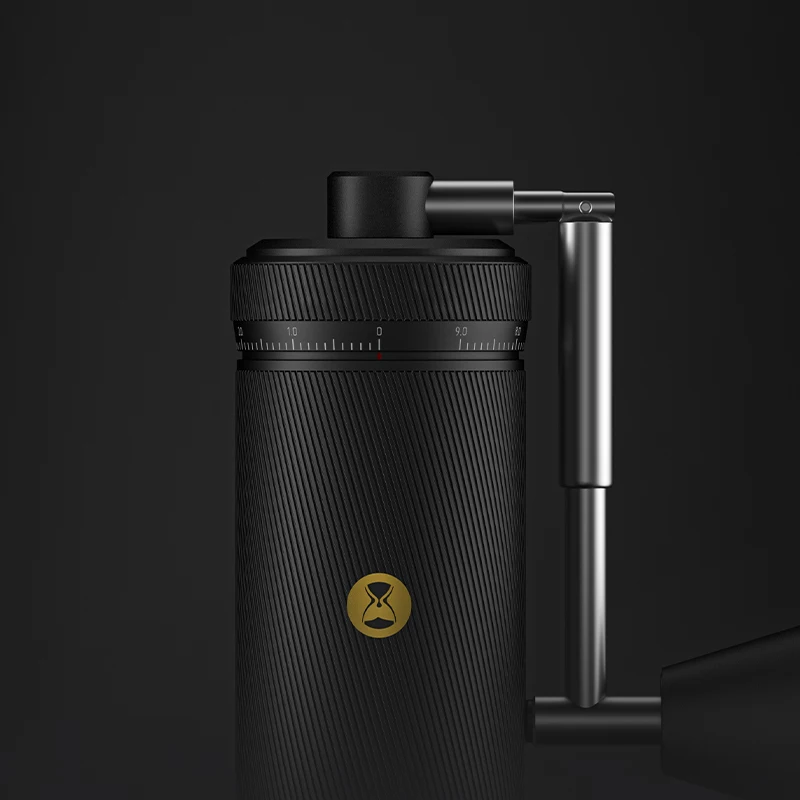
Step-by-Step Process: Finding Your Optimal Grind Size
Follow this systematic approach to dial in your espresso grind size. The key is changing only one variable (grind size) while keeping everything else consistent:
Establish Your Baseline Parameters
– Choose a standard dose (typically 18g for double shot)
– Set target yield (typically 36g, a 1:2 ratio)
– Aim for 25-30 second extraction time
– Use fresh beans (7-21 days off roast)
– Maintain consistent tamping pressureStart with an Educated Guess
– If your grinder has numbered settings, begin in the middle of the “espresso range”
– If no guidance exists, start with a texture similar to fine sugar
– When in doubt, start slightly coarser—it’s easier to adjust finer than recover from too finePrepare Your Shot with Consistency
– Weigh your dose precisely (e.g., exactly 18.0g)
– Distribute grounds evenly in portafilter
– Apply consistent tamping pressure
– Lock portafilter into group head without disturbing puckPull the Shot and Observe
– Start timer when pump starts
– Place cup on scale to monitor yield
– Watch flow development and color
– Stop at target yield (e.g., 36g) and note total timeEvaluate Results
– If shot runs under 20 seconds: Grind is too coarse
– If shot runs over 35 seconds: Grind is too fine
– If within time range: Taste and assess (sour = too coarse, bitter = too fine)Make Precise Adjustments
– For too fast shots: Adjust 1-2 settings finer
– For too slow shots: Adjust 1-2 settings coarser
– For minor taste adjustments: Make micro-adjustmentsRepeat the Process
– Pull another shot with new grind setting
– Make only ONE adjustment between shots
– Continue until your shot hits target time AND tastes balancedDocument Your Settings
– Record successful grind setting for future reference
– Note the coffee variety and roast date
– Track environmental conditions if possible
This methodical approach to precision grind adjustment espresso may take 3-5 attempts to dial in properly, but the process becomes faster with practice. Remember that perfect extraction balances time, yield, and most importantly, taste—sometimes a “technically imperfect” shot might taste better than one that meets all the numerical targets.
Creating a Grind Adjustment System for Your Specific Grinder
Different grinders use different adjustment mechanisms, scales, and terminology. Creating a personalized system for your specific grinder helps maintain consistency and makes dialing in faster:
Grinders with Numbered Settings
Many electric burr grinders provide numbered scales or “steps.” While these numbers aren’t standardized between brands, they provide useful reference points:
- Baratza Encore/Virtuoso: Typically between settings 5-8 for espresso
- Breville Smart Grinder Pro: Usually in the 10-15 range
- Rancilio Rocky: Often around 5-10 for espresso
- Eureka Mignon: Around 1-3 on their dial system
Stepless Grinders
These offer infinite adjustment but can be harder to calibrate:
- Mark your collar/dial with tape or non-permanent marker to create reference points
- Use clock positions as references (e.g., “between 10 and 11 o’clock”)
- Count the number of turns from “zero point” (burrs touching)
- Take photos of successful settings for visual reference
Manual Grinders
High-quality fine adjustment hand grinder options often use click systems:
- Count clicks from zero point (burrs fully closed)
- Most quality manual espresso grinders need 5-10 clicks from zero
- Maintain consistent speed while grinding for best results
Creating Micro-Adjustments
For grinders with limited adjustment range:
– Use distribution techniques to compensate (WDT method)
– Adjust dose slightly (±0.5g) to fine-tune extraction
– Consider aftermarket adjustment mechanisms for popular models
Remember that different coffees will require different settings, even on the same grinder. Darker roasts typically need coarser settings than lighter roasts. Document successful settings for each coffee to build a personal reference database over time.
Troubleshooting Common Grind-Related Problems
Even with careful adjustment, you may encounter persistent extraction issues. Here’s how to diagnose and solve common problems:
Channeling (Water Finding Paths of Least Resistance)
- Symptoms: Uneven flow, spurting, holes in spent puck, mixed bitter/sour taste
- Causes: Uneven distribution, improper tamping, too fine grind
- Solution: Improve distribution technique, ensure level tamping, slightly coarsen grind
Inconsistent Shot Times
- Symptoms: Same grind setting produces varying extraction times
- Causes: Inconsistent dosing, grinder retention issues, temperature fluctuations
- Solution: Weigh doses precisely, purge grinder between adjustments, warm up machine fully
Machine Choking
- Symptoms: No flow or extremely slow drips, machine straining
- Causes: Grind far too fine, excessive dose, over-tamping
- Solution: Significantly coarsen grind (2-4 settings), verify correct dose
Persistent Sourness Despite Finer Grind
- Symptoms: Sour taste remains even when shot runs slow
- Causes: Water temperature too low, coffee too fresh (under 5 days post-roast)
- Solution: Increase brew temperature if possible, let coffee rest longer, try slightly higher yield ratio
Persistent Bitterness Despite Coarser Grind
- Symptoms: Bitterness dominates even when flow seems correct
- Causes: Water temperature too high, dark roast requiring even coarser grind, over-extraction
- Solution: Lower brew temperature if possible, try shorter extraction (lower yield), consider reducing dose
Donut Extraction (Center Dead Spot)
- Symptoms: Center of puck seems dry, extraction concentrated at edges
- Causes: Distribution issue, often from dosing technique
- Solution: Improve distribution method, try different distribution tool
Understanding these common issues and solutions will significantly improve your ability to adjust grind size espresso shot timing and troubleshoot extraction problems methodically rather than through random adjustments.
Beyond Grind: Other Factors Affecting Espresso Extraction
While grind size is the primary adjustment parameter, several other variables interact with grind to affect espresso extraction:
Dose Weight
- Standard range: 14-21g for double shots
- Higher doses require slightly coarser grind for equivalent flow
- Lower doses typically need slightly finer grind
- Changing dose by 0.5g can significantly impact extraction
Bean Freshness and Roast Level
- Fresh beans (7-21 days off roast) extract best
- Very fresh beans (<7 days) may need coarser grind due to CO2 release
- Darker roasts generally require coarser grind than lighter roasts
- Older beans typically need finer grind as they degas
Tamping Technique
- Consistent pressure (about 30 pounds) matters more than exact amount
- Level tamp is crucial to prevent channeling
- Modern “precision” tampers reduce variability
- Tamping harder does NOT compensate for grind that’s too coarse
Water Temperature and Quality
- Higher temperatures extract more quickly (may need coarser grind)
- Lower temperatures extract more slowly (may need finer grind)
- Mineral content affects extraction (soft water typically needs finer grind)
- Temperature stability during shot affects consistency
Distribution Technique
- Even distribution prevents channeling
- WDT method (stirring with fine needles) can compensate for grinder issues
- Poor distribution amplifies problems with incorrect grind size
Understanding the relationship between espresso grind size light dark roasts and other variables allows you to make holistic adjustments when necessary. While dialing in, try to change only one variable at a time to understand its impact clearly.
Fine Adjustment Hand Grinder, Precision Manual Grinder, Travel Coffee Grinder
Price range: $185.11 through $494.63 Select options This product has multiple variants. The options may be chosen on the product pageHand Burr Grinder, Hand Crank Coffee Grinder, Manual Espresso Grinder, Portable Coffee Grinder
Price range: $262.72 through $300.22 Select options This product has multiple variants. The options may be chosen on the product pageHand Burr Grinder, Manual Coffee Grinder Stainless Steel, Precision Manual Grinder
Price range: $183.64 through $187.52 Select options This product has multiple variants. The options may be chosen on the product pageCeramic Burr Coffee Grinder, Hand Burr Grinder, Hand Crank Coffee Grinder, Manual Coffee Bean Grinder
Price range: $59.17 through $59.96 Select options This product has multiple variants. The options may be chosen on the product page
Grind Size Adjustments for Different Espresso Styles
Different espresso styles require specific grind adjustments to achieve their characteristic flavor profiles:
| Style | Ratio | Time | Grind Adjustment | Flavor Profile |
|---|---|---|---|---|
| Traditional Italian | 1:1.5-2 | 25-30s | Baseline reference | Balanced, rich, moderate sweetness |
| Ristretto | 1:1-1.5 | 20-25s | 10-15% finer | Concentrated, intense, high sweetness |
| Lungo | 1:3-4 | 30-35s | 10-15% coarser | More dilute, higher extraction, lighter body |
| Light Roast | 1:2-2.5 | 25-35s | Generally finer | Brighter acidity, floral, fruit-forward |
| Dark Roast | 1:1.5-2 | 22-28s | Generally coarser | Chocolate, caramel, lower acidity |
| Pressure-Profiled | Varies | 30-40s | Often finer | Complex, layered flavors with extended pre-infusion |
For ristretto preparation, the finer grind restricts flow to create a more concentrated extraction with heightened sweetness and intensity. The shorter extraction time means fewer bitter compounds are pulled.
With lungo, the slightly coarser grind allows more water to pass through the coffee, extracting compounds that don’t appear in standard shots. This creates more complexity but reduces intensity.
Modern light-roast espresso often benefits from finer grinding combined with higher brewing temperatures to properly extract the dense cellular structure of lightly roasted beans.
Using precision manual grinder options with fine adjustment capabilities makes transitioning between these styles significantly easier, as they allow for the micro-adjustments necessary to optimize extraction for each style.

How Grind Consistency Impacts Extraction Quality
The consistency of your grind—how uniform the coffee particles are—dramatically affects extraction quality, sometimes even more than the average size itself. Here’s why it matters:
When coffee particles are consistent in size, they extract at similar rates, creating balance. However, all grinders produce a mix of particle sizes:
- Target particles extract properly and contribute balanced flavors
- Fines (very small particles) extract quickly, adding bitterness
- Boulders (larger particles) extract slowly, adding sourness
Lower-quality grinders produce more inconsistent distribution with excessive fines and boulders, creating confused flavors where sourness and bitterness appear simultaneously—a problem that can’t be solved through grind size adjustment alone.
With high-quality burrs, you achieve more uniform particle distribution, meaning your grind size adjustments have predictable, consistent effects on extraction. This is visible during extraction through:
- Even color development without blonding or striping
- Consistent flow without spurting or dead spots
- Uniform wetness in spent puck
- Clean, clear flavor separation in the cup
The difference becomes most apparent in naked portafilter extraction, where uneven particle distribution creates visible channeling—streams of water finding paths of least resistance through the puck.
Quality manual espresso grinder options often provide exceptional consistency due to their precision-machined burrs and stable grinding mechanisms, sometimes outperforming electric grinders costing much more.
Can You Measure Espresso Grind Size Precisely?
Many espresso enthusiasts wonder if there’s a way to measure grind size with precision rather than relying on visual assessment. Here’s what you should know:
Professional Measurement Methods
Coffee labs use laser particle size analyzers that can precisely measure particle distribution across the entire range. These devices show not just average particle size but the distribution curve—how many particles fall into each size category. However, they cost thousands of dollars and aren’t practical for home use.
Home Measurement Limitations
Consumer-level measurement tools like sieves can give rough estimates but lack the precision needed for espresso’s tight tolerances. Digital microscopes can visualize particles but don’t easily translate to actionable adjustments on your grinder.
Why Measurements Aren’t Enough
Even if you could measure precisely, the numbers alone wouldn’t guarantee good extraction because:
– Different coffee varieties and roasts behave differently at the same particle size
– The shape of particles matters as much as size (some grinders create more angular particles)
– Distribution curve (consistency) matters more than average size
– Environmental factors affect how particles interact with water
Practical Alternatives
Instead of chasing technical measurements, focus on:
– Visual comparison cards (available online) with magnified images
– Developing sensory skills through practice
– Consistent measurement of inputs (dose) and outputs (yield, time)
– Keeping detailed notes on successful combinations
For context, espresso typically falls in the 200-400 micron range, compared to drip coffee’s 600-800 microns, but the definitive guide espresso grind size flavor relationship is too complex to reduce to a simple number.
Maintaining Grinder Performance for Consistent Results
A well-maintained grinder delivers consistent results over time. Follow these practices to ensure optimal performance:
• Regular Cleaning Schedule
– Deep clean burrs every 1-2 months for home use
– Use grinder-specific cleaning products or uncooked rice/grindz
– Pay special attention to the burr chambers and exit chute
– Remove coffee oils that can become rancid and affect flavor
• Managing Static and Retention
– Use the “Ross Droplet Technique” (adding a few drops of water to beans)
– Tap the grinder after grinding to dislodge retained grounds
– Consider single-dosing workflows to minimize retention
– Use soft brushes to remove grounds from retention points
• Burr Seasoning and Wear
– New burrs require “seasoning” (grinding 2-5 pounds of cheap coffee)
– Burrs gradually wear with use, requiring finer settings over time
– Monitor extraction consistency as an indicator of wear
– Consider replacement after grinding approximately 1000 pounds (450kg)
• Alignment Considerations
– Higher-end grinders benefit from burr alignment checks
– Misaligned burrs create inconsistent particle distribution
– Some grinders allow user adjustment of alignment
– Professional servicing may be needed for precision alignment
Quality burrs and proper maintenance dramatically affect consistency, which is why why burr grinders essential espresso preparation cannot be overstated. A well-maintained grinder with quality burrs can outperform a more expensive but poorly maintained machine.
Adapting Grind Size as Coffee Beans Age
Coffee is a dynamic product that changes significantly over time after roasting. These changes require ongoing grind adjustments:
Days 1-3 post-roast:
– Beans are releasing significant CO2 (degassing)
– Often too fresh for optimal espresso extraction
– If used, typically require slightly coarser grind
– May exhibit inconsistent extraction and excessive crema
Days 4-10 post-roast:
– Prime window for most espresso beans
– Baseline grind setting established
– Most stable extraction characteristics
– Optimal flavor development and balance
Days 11-21 post-roast:
– Gradual degradation begins
– Require progressively finer grinding (adjust 1-2 steps finer every 5-7 days)
– Crema production diminishes
– Extraction speeds up as internal bean structure breaks down
Beyond 3-4 weeks:
– Significant flavor loss occurs
– Requires much finer grinding
– Shots may run faster despite grind adjustments
– Thin body and flat taste profile becomes evident
– Eventually becomes unsuitable for quality espresso
Observable changes as beans age include:
– Diminishing aroma
– Lighter colored crema that dissipates quickly
– Faster flow rates at the same grind setting
– Less resistance when tamping
Using quality hand burr grinder options with precise adjustment capabilities makes it easier to adapt to these changes, allowing for the small incremental adjustments needed to maintain consistent extraction as beans age.
Frequently Asked Questions About Espresso Grind Size
What’s the minimum grinder quality needed for espresso?
Entry-level espresso-capable grinders start around $200-250 for electric models. Look for true burr grinders (not “false burrs”) with fine enough adjustment range. Premium manual grinders often provide better grinding quality than similarly priced electric models.
Can I use pre-ground espresso coffee?
Pre-ground coffee is not recommended for espresso due to rapid staling (within minutes) and inability to adjust grind size. Even the highest quality pre-ground coffee cannot be adjusted to match your specific machine and beans.
Does single-dosing affect grind consistency?
Yes. Grinders designed for hopper use may produce less consistent results when single-dosing due to reduced bean weight/pressure. Using specialized single-dose hoppers or bean weights can help maintain consistency.
Are stepless grinders better than stepped grinders?
Stepless grinders offer infinite adjustment but can be harder to maintain consistent settings. Stepped grinders with small increment steps (like 1mm or less) offer good precision while being easier to replicate settings. For espresso, having at least 30+ steps in the espresso range is ideal.
How does humidity affect grind size?
Higher humidity typically requires slightly coarser grinding as beans absorb moisture. Seasonal adjustments are often necessary, with finer grinding needed in dry winter months and coarser grinding in humid summer conditions.
Why do light roasts need finer grinding than dark roasts?
Light roasts are denser with harder cellular structure, requiring finer grinding to expose sufficient surface area. Dark roasts are more brittle and porous, extracting more readily with coarser grinding. The difference can be 3-5 grind settings between very light and very dark roasts.
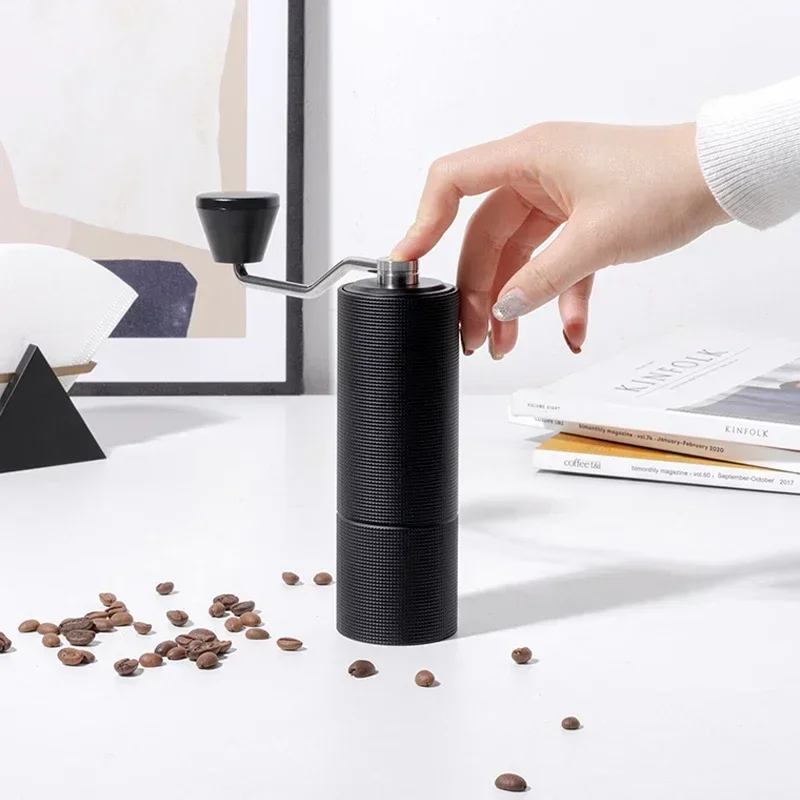
When to Trust Your Taste Over Technical Parameters
While technical parameters provide useful guidelines, personal taste preference should ultimately drive your grind adjustments. Here’s when to prioritize taste over “rules”:
A shot that runs in 22 seconds but tastes balanced and delicious to you is objectively better than a 30-second shot that meets textbook parameters but tastes bitter to your palate. The technical guidelines exist to help you find good extraction, not to dictate what you should enjoy.
Professional baristas don’t rigidly adhere to formulas—they adjust recipes to highlight each coffee’s unique characteristics. As you gain experience, you’ll develop preferences that might deviate from standard recommendations:
- You might prefer slightly longer ratios (1:2.5) for certain light roasts to highlight clarity
- You might enjoy shorter shots (1:1.5) with medium-dark roasts for intensity
- Some beans simply taste better outside the “standard” 25-35 second window
The concept of diminishing returns also applies to grind adjustment obsession. After reaching a reasonably good extraction, microscopic adjustments might create differences so subtle that they don’t meaningfully improve enjoyment.
Developing confidence in your palate takes time, but understanding perfect espresso grind size is ultimately about finding what tastes best to you, not what fits a textbook definition.
Transitioning from Beginner to Expert: Developing Your Grind Intuition
With practice, what initially seems like a technical challenge becomes intuitive. Here’s how to develop your sensory skills and grind intuition:
Start keeping an espresso journal that records:
– Date
– Coffee (origin, roaster, roast date)
– Grind setting
– Dose in grams
– Yield in grams
– Extraction time
– Detailed tasting notes
– Adjustments made for next attempt
This systematic tracking accelerates your learning curve. After dialing in 5-10 different coffees, you’ll begin recognizing patterns and anticipating necessary adjustments.
Develop a consistent tasting vocabulary. Rather than just “good” or “bad,” describe specific flavors and sensations: “bright apple acidity,” “chocolate finish,” “silky mouthfeel.” This precision helps connect sensory experiences to specific grind adjustments.
Practice blind tasting when possible. Prepare shots at different grind settings without knowing which is which, then evaluate based purely on taste. This builds confidence in your palate’s ability to detect subtle differences.
Learn to trust your visual assessment skills. Eventually, you’ll be able to look at ground coffee and immediately recognize if it’s in the right ballpark for your equipment.
Quality espresso coffee hand grinders provide valuable tactile feedback during grinding that helps develop intuition about bean density and appropriate grind settings based on resistance felt during grinding.
Summary: Your Path to Perfect Espresso Grind
Finding your ideal espresso grind size isn’t about chasing a magic number but developing a methodical approach to extraction. The systematic path we’ve explored emphasizes:
- Understanding the fundamental relationship between grind size and extraction
- Recognizing visual and taste indicators of proper extraction
- Making deliberate, incremental adjustments to achieve balance
- Maintaining consistency in all other variables during the dialing-in process
- Using taste as your ultimate guide while understanding technical parameters
Remember that espresso extraction is inherently dynamic, requiring ongoing adjustments as beans age, seasons change, and even as your grinder’s burrs wear over time. Patience and attention to detail are essential—rushing adjustments leads to confusion and inconsistent results.
Investing in a quality burr grinder stands as the foundation of great espresso. No technique can compensate for inconsistent grinding, while even modest espresso machines can produce excellent shots with properly ground coffee.
With practice, what begins as a technical challenge transforms into intuitive craft. The reward—consistently delicious espresso tailored precisely to your taste preferences—makes the learning journey worthwhile.
Why Quality Grinders Make All the Difference
The grinder is unquestionably the most important piece of equipment in your espresso setup. Here’s why grinder quality fundamentally determines your espresso potential:
Quality burr grinders produce significantly more uniform particles with fewer “fines” (dust-like particles) and “boulders” (oversized chunks). This consistency creates even extraction where water contacts all particles similarly rather than over-extracting some while under-extracting others.
Premium burr sets differ from entry-level options in several key ways:
• Precision-machined cutting surfaces with tighter tolerances
• Better materials that maintain sharpness longer
• Improved alignment that ensures consistent distance between burrs
• More stable operation with less vibration during grinding
The difference becomes apparent through:
• Noticeably improved shot consistency
• Ability to extract lighter roasts effectively
• Smoother, sweeter flavor profile with less bitterness
• Wider adjustment range that allows fine-tuning
While electric grinders typically cost more for equivalent quality, premium manual grinders offer an excellent alternative. Their precision-machined burrs, combined with stable grinding mechanisms, often outperform electric grinders costing twice as much.
When evaluating grinders, prioritize burr quality and adjustment precision over features like timers or hoppers. The core grinding mechanism determines the ceiling of your espresso quality, regardless of other variables in your setup.


